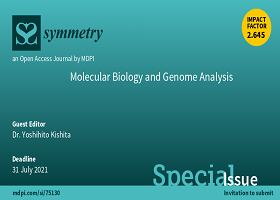- 2.2Impact Factor
- 5.3CiteScore
- 18 daysTime to First Decision
Molecular Biology and Genome Analysis
This special issue belongs to the section “Life Sciences“.
Special Issue Information
Dear Colleagues,
The development of genome analysis technology has been remarkable, and the technological progress of next-generation sequencing is constantly advancing. By targeting DNA, RNA, and epigenetic changes to genome analysis, not only the genome sequence but also gene expression and regulation can be revealed. These sequencing technologies have led to the elucidation of the causes of various diseases in the clinical research field, but also in basic research, the genomes of various species have been revealed, and the evolutionary background has been clarified. Today, single-cell sequencing technologies are gaining momentum, and genome analysis at the cellular level has become possible. The details of developmental processes and tissue formation involving symmetry and asymmetry have been revealed by this technology. Single-cell sequencing is increasingly being applied to the medical field, particularly to reveal pathological conditions at the cellular level.
The scope of this Special Issue will cover discoveries in molecular biology revealed by extensive genome analysis research. In particular, we would like to accept biological phenomena and pathogenic mechanisms of diseases that have been revealed through comprehensive genome analysis. In addition, proposals for new genome analysis technologies and technological improvements are also acceptable.
Dr. Yoshihito Kishita
Guest Editor
Manuscript Submission Information
Manuscripts should be submitted online at www.mdpi.com by registering and logging in to this website. Once you are registered, click here to go to the submission form. Manuscripts can be submitted until the deadline. All submissions that pass pre-check are peer-reviewed. Accepted papers will be published continuously in the journal (as soon as accepted) and will be listed together on the special issue website. Research articles, review articles as well as short communications are invited. For planned papers, a title and short abstract (about 250 words) can be sent to the Editorial Office for assessment.
Submitted manuscripts should not have been published previously, nor be under consideration for publication elsewhere (except conference proceedings papers). All manuscripts are thoroughly refereed through a single-blind peer-review process. A guide for authors and other relevant information for submission of manuscripts is available on the Instructions for Authors page. Symmetry is an international peer-reviewed open access monthly journal published by MDPI.
Please visit the Instructions for Authors page before submitting a manuscript. The Article Processing Charge (APC) for publication in this open access journal is 2400 CHF (Swiss Francs). Submitted papers should be well formatted and use good English. Authors may use MDPI's English editing service prior to publication or during author revisions.
Keywords
- Genome analysis
- Molecular biology
- Variant
- Chromosome
- Epigenetics
- Gene expression
- Genetic disease
- Evolution
- Development

Benefits of Publishing in a Special Issue
- Ease of navigation: Grouping papers by topic helps scholars navigate broad scope journals more efficiently.
- Greater discoverability: Special Issues support the reach and impact of scientific research. Articles in Special Issues are more discoverable and cited more frequently.
- Expansion of research network: Special Issues facilitate connections among authors, fostering scientific collaborations.
- External promotion: Articles in Special Issues are often promoted through the journal's social media, increasing their visibility.
- e-Book format: Special Issues with more than 10 articles can be published as dedicated e-books, ensuring wide and rapid dissemination.

